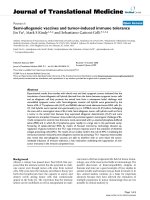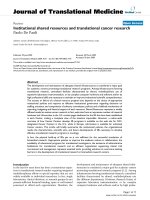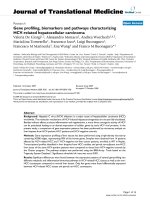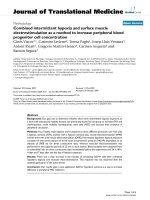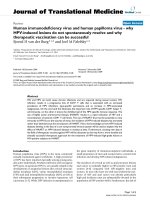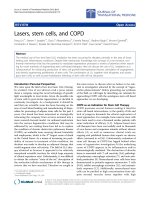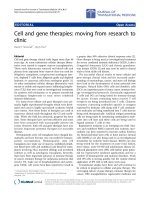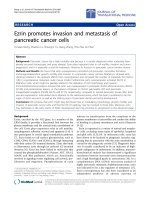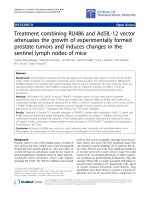báo cáo hóa học: " Occupational health legislation and practices related to seafarers on passenger ships focused on communicable diseases: results from a European cross-sectional study (EU SHIPSAN PROJECT)" pot
Bạn đang xem bản rút gọn của tài liệu. Xem và tải ngay bản đầy đủ của tài liệu tại đây (215.68 KB, 7 trang )
RESEARC H Open Access
Occupational health legislation and practices
related to seafarers on passenger ships focused
on communicable diseases: results from a
European cross-sectional study (EU SHIPSAN
PROJECT)
George Rachiotis
1
, Varvara A Mouchtouri
1
, Clara Schlaich
2
, Tobias Riemer
2
, Carmen Varela Martinez
3
,
Gordon Nichols
4
, Christopher LR Bartlett
5
, Jenny Kremastinou
6
, Christos Hadjichristodoulou
1*
,
the SHIPSAN partnership**
Abstract
Background: Seafarers play an important role in the transmission of communicable diseases. The aim of the
present study is to draw information and identify possible gaps on occupational health practices related to
seafarers sailing on ships within the European Union Member States (EU MS) with focus on communicable
diseases.
Methods: A structured questionnaire was sent to competent authorities from 21 EU MS. The questionnaire
included questions about occupational health policies, medical certification of seafarers, communicable diseases
reporting and relevant legislation. Descriptive analysis of the data was conducted by the use of Epi Info software:
EU MS were categorized in four priority groups (A, B, C, D) based on: number of passenger ships visits, volume of
passengers, and number of ports in each country. Moreover, EU MS were categorized to old and new, based on
the date of entry in the EU.
Results: All 21 countries with relevant competent authorities responded to the questionnaire. The existence of
specific national legislation/regulation/guidelines related to vaccination of seafarers was reported by three out of
the 21 (14%) responding authorities. Surveillance data of communicable diseases related to seafarers are collected
and analyzed by 4 (1 9%) authorities. Five out of 21 of the responding countries (24%) reported that tuberculin test
result is required for the issuance of seafarer’s medical certificate while a great variety of medical examination is
required for the issuance of this certificate among countries.
Gaps on occupational health services focused on communicable diseases related to maritime occupation have
been rep orted by 33% of the responding countries.
Responding authorities from Group A and B had the highest percentage of reported gaps followed by groups C
and D. Old MS reported a higher frequency regarding gaps on occupational health services in comparison to new
MS.
Conclusion: Our results revealed heterogeneity regard ing occupational health of maritime employees in EU MS.
This work provides some evidence that further work at international and European level could be considered, in
order to explore the potential for harmonized initiatives regarding occupational health of seafarers.
* Correspondence:
1
Department of Hygiene and Epidemiology, Faculty of Medicine, University
of Thessaly, 22 Papakiriazi Str., Larissa, 41222, Greece
Rachiotis et al. Journal of Occupational Medicine and Toxicology 2010, 5:1
/>© 2010 Rachiotis et al; licensee BioMed Central L td. This is an Open Access article distributed under the terms of the Creative
Commons Attribution License ( which permits unrestricted use, distribution, and
reproduction in any medium, provided the original work is properly cited.
Background
The shipping industry has grown rapidly in recent years,
and dramatic increases in size an d passenger capacity
have been recorded. The cargo shippi ng industry is al so
growing. The w orld merchant fleet comprises 1.4 mil-
lion seafarers of whom two thirds work within multieth-
nic crews. It is expected that twenty mil lion people will
sail on cruise ships in the year 2010 [1]. Moreover, the
morbidity of maritime employees in the period of globa-
lization is an important issue for occupational health
care in the shipping industry [2,3].
It is widely accepted that seafaring is considered a high
risk job in terms of health and safety at work, while pro-
vision of health care aboard is a very complex question
[4]. Seafarers by nature of their work are exposed to a
variety of occupational hazards making exposure to bio-
logical agents and the concomitant risk of communicable
diseases extremely important w ithin this working group
[5]. Maritime em ployees can travel to various geographi-
cal areas, far away from their own countries. Conse-
quently, they are at risk of contracting infectious diseases
at ports of call in different countries. In 1993 the com-
mon committee of International Labor Organization
(ILO), and World Health Organization (WHO) identified
Hepatitis B virus infection (HBV), Immunodeficiency
Virus infection (HIV), and Acquired Immunodeficiency
Syndrome (AIDS) as infectious diseases against which
there should be provisions for guidance on prevention
[6]. Furthermore, the possibility that a seafarer may
transmit biological agents to other persons, could be
associated with public health implications, and contribute
to trans-national transmission of communicable diseases.
The framework of pre-medical examination of seafarers
is given by international conventions, na tional statutory
systems and company requirements. The requirement for
seafarers to have a certificate of medical fitness is stipu-
lated in general terms on ILO and International Maritime
Organisation (IMO) conventions - most recently in the
Maritime Labou r Convention of 2006 [7,8]. The WHO
collaborated with ILO to produce the 1997 Guidelines for
Conducting Pre- sea an d Peri odic Medica l Fitness exami-
nations [9]. These international conventions are addressed
to the maritime regulatory bodies in the countries that
ratify the conventions. Each countr y then produces its
own regulations that have to meet the minimum standards
in the conventions but may add additional requirements.
There is currently no legal or technical framework
produced by the European Council in the criteria for
the fitness assessment of seafarers.
Epidemiological research on maritime employees has
been concerned - mainly-withnationalstudies.How-
ever, the need for international studies has been pointed
out [10]. Up to now there is no published information
on occupational health legislation and practices related
to maritime employees with emphasis o n communicable
diseases which is applied by the competent authorities
of EU MS.
The aim of our work within t he context of the SHIP-
SAN project was to draw information from competent
authorities o f EU MS regarding legislation and practice
related to seafarer’s occupational health and gaps on
occupational health services provided to seafarers
focused on communicable diseases.
Methods
The survey was performed within the EU SHIPSAN
project. A preliminary quest ionnaire was sent to all EU
MS in order to id entify the relevant competent autho ri-
ties. Thereafter, a detailed questionnaire was constructed
and sent to competent authorities in 21 countries
(which were identified from the preliminary question-
naire). The qu estionnaire included questio ns on: a)
national legislation or regulation, or guideline for occu-
pational health of seafarers, b) the existence of addi-
tional institutions next to the national public healt h
institutions where communicable diseases of seafarers
are reported, c) the collection and central analysis of
surveillance of communicable diseases data related to
seafarers, d) the vaccination of maritime employe es,
beside Yellow fever which is mandatory under IHR 2005
[11], e) the issuance of seafarer’ s certificates, f) medical
examination of food handlers who are employed to
work on ships and gaps on occupational health services
provided to seafarers with focus on communicable dis-
eases (additional file 1).
EU MS were categorized in four priority gro ups (A, B,
C, D) based on: number of passenger ships, volume of
passengers, and number of ports. Moreover, EU MS
were categorized to old and new based on the date of
entry in the European Union. The questionnaire was
pilot tested in Germany and Malta. In order to ensure
data collection from the high priority group A of EU
MS, site visits were organized. Data collected were
entered in an electronic database. Descriptive analysis
was conducted, and Fischer’s exacts te st was used as the
Univariate analysis for comparisons between different
groups. Sta tistical analysis wa s performed by the use of
Epi-Info software. The l evel of statistical significance
was <0.05.
Results
Five countries didn’ t respond to the preliminary ques-
tionnaire, and three countries reported no competent
authority.
Twenty one MS reported the existence of a national
competent authority and all participated in the study.
Rachiotis et al. Journal of Occupational Medicine and Toxicology 2010, 5:1
/>Page 2 of 7
Four out of 21 (19%) EU MS (Croatia, Malta, Italy and
Poland) repo rted the existence of additional institutions
next to the national public health institutions where
communicable diseases of seafarers are reported to
Table 1. These countries more often reported the exis-
tence of specific national legislation or regulation or
guidelines related to vaccination of seafarers in compari-
son to countries without these additional institutions.
Three out of 13 (23%) of the responders of Groups A
and B reported that the surveillance data of communic-
able diseases related to seafarers a re collected and cen-
trally a nalyzed but none in the groups C and D (Table
2). Eleven out of 21 (52.4%) of the responding countries
reported the existence of specific national legislation or
regulation or guideline for seafarer’s occupational health
beside the EU or International Maritime Organization
or of the International Labor Organization directives or
conventions. Analysis of the results by priority group
showed that 8 out of 13 (61.5%) EU M S responding
authorities (belonging to Groups A and B) reported the
existence of specific national legislation related to sea-
farer’ s occupational health, while only 37.5% from
Groups C and D reported the existence of such legisla-
tion (Table 2).
Overall, only five out of 21 responders (24%) reported
the existence of addi tional national recommendation for
vaccination of seafarers except for Yellow Fever which is
mandatory under the International Health Regulation
2005. New EU MS reported the existence of additional
institutions next to the national public health institu-
tions where communicable diseases related to maritime
occupation are reported more often compared to old
EU MS (30%; versus 9.1% respectively; Table 3). Only
three out of 21 (14.2%) of the EU MS which participated
in the survey stated that national data of surveillance of
communicable diseases related to seafarers were col-
lected and centrally analyzed.
Regarding seafarers medical certificate, re quired medi-
cal examinat ions and tests vary between nations: Vision
and hearing function tests are performed by 84,6% of
the responders while X-Rays, blood tests, and tuberculo-
sis skin test were performed by 57.7%, 50.0%, and 19.2%,
respectively. Thirteen (61.9%) countries required dental
check of seafarers (Table 1). Four out of 13 (30.8%) of
the countries from priority groups (A and B) reported
that tuberculin test result were required for the issuance
of seafarer’ s medical certificate, while only one out of 8
(12.5%) of the countries from Groups C and D required
Table 1 Occupational health legislation and practices in the EU MS.
Subject area Yes/Total Percent
Specific National Legislation or regulation or guideline for Occupational Health of seafarers except for EU or International
Maritime Organisation or of the International Labour Organisation?
11/21 52.4%
Additional Institutions next to the national public health institutions where Communicable diseases of seafarers are reported 4/21 19%
Collection and analysis of surveillance of communicable disease data related to seafarers 3/21 14.2%
Specific national legislation or regulation or guideline for vaccination of Seaferers 3/21 14.2%
Additional National Recommendations for vaccinations of seafarers except those required by the IHR? 5/21 24%
Are Medical certificates obligatory in order for seafarers to travel? 20/21 95.2%
Medical Certificates: Medical Examinations Required History of communicable diseases plus clinical examinations 17/21 81%
Vision function tests 20/21 95.2%
Hearing function tests 20/21 95.2%
Dental Check 13/21 61.9%
Blood Tests 12/21 57.1%
X-Rays 14/21 66.7%
Tuberculin tests 5/21 23.8%
Other 11/21 52.4%
Do the medical certificates have time frame duration? 21/21 100%
In your opinion are there any gaps in occupational health services focused in communicable diseases related to maritime
occupation
7/21 33.3%
Rachiotis et al. Journal of Occupational Medicine and Toxicology 2010, 5:1
/>Page 3 of 7
the tuberculosis skin test results for the same purpose
(Table 2). Only one country required blood tests for the
detection of HIV antibodies. Only 10% (1 out of 10
responder s) of the new MS repor ted the requirement of
s tuberculosis skin test (TST) for the issuance of sea-
farer’s medical certificate. On the contrary, 28.6% (4 out
of 14 responders) from old MS did report that TST is a
prerequisite for the issuance of seafarer ’s medical certifi-
cate (p value = 0.18; Table 3). Regarding the validity of
the certific ates the responders reported a variation from
1 to 5 years. Six out of 21 countries reported that the
duration of validity of two years is shortened in elderly
seafarers (e.g. >50 years) to only one year.
In addition, only one country reported the require-
ment of HACCP training for food handlers working on
board.
Seven out of 21 of the responders (33%) reported that
they identified gaps in occupational health services
focused on communicable diseases (Table 1). Respond-
ing authorities from Group A and B had the highest
percentage of repor ted gaps (46.2%) followed by group
C and D (12.5%) (p = 0.17; Table 2).
Finally, old MS reported a higher frequency regarding
gaps in occupational health services in comparison to
new MS (45.5% versus 20% respectively; Table 3). The
most commonly reported gap by competent authorities
was the medical examinations performed in other coun-
tries for the issuance of seafarers’ medical certificate.
The prevalent example given by the competent authori-
ties was related to the tuberculin skin test. Other
reported gaps included the absence of a surveillance sys-
tem related to infectious diseases associated to maritime
occupation and the absence of specific legislation related
to health and safety of maritime employees.
Discussion
This study-in the context of the SHIPSAN project-pre-
sents for the first time original information about occu-
pational health legislation and practices of competent
authorities related to communicable diseases in
Table 2 Analysis of the results by priority group
Priority groups
Question (A+B) (C+D) p
value
Yes/
Total
% Yes/
Total
%
Is there any specific national legislation or regulation or guidelines related to occupational health of
seafarers except for that of EU or of the International Maritime Organisation (IMO) or of the International
Labour Organization (ILO)?
8/13 61.5% 3/8 37.5 0.26
Are the surveillance of communicable diseases data related to seafarers collected and centrally
analysed?
3/13 23% 0/8 0 0.25
Is there any specific national legislation or regulations or guidelines related to vaccination of seafarers? 3/13 23% 0/8 0 0.25
Dental check 10/13 76.9% 3/8 37.5 0.08
Blood tests 6/13 46.2% 6/8 75 0.20
Tuberculin tests 4/13 30.8% 1/8 12.5 0.34
In your opinion are there any gaps in occupational health services focused in communicable diseases
related to maritime occupation?
6/13 46.2% 1/8 12.5 0.17
Table 3 Comparison of the results between Old and New Member States *
Member States
Question New Old P
value
Yes/
Total
% Yes/
Total
%
Are there additional institutions next to the national public health institutions where communicable
diseases of seafarers are reported to?
3/10 30 1/11 9.1 0.31
Blood tests 9/10 90 3/11 27.3 0.005
Tuberculin tests 1/10 10 4/11 36.4 0.18
In your opinion are there any gaps in occupational health services focused in communicable diseases
related to maritime occupation?
2/10 20 5/11 45.5 0.36
Rachiotis et al. Journal of Occupational Medicine and Toxicology 2010, 5:1
/>Page 4 of 7
seafarers, and gaps in occupational health services pro-
vided to seafarers focused on communicable diseases,
among EU MS. Differences regarding legislation related
to occupational health of seafarers, collection and analy-
sisofsurveillancedatarelated to communicable dis-
eases, vaccination recommendations, and medical
certificates of seafarers were of special interest for this
survey in the context of the EU SHIPSAN project.
The analysis of the results reveal ed differences among
countries with a high volume of traffic from passenger
ships as compared to those with a lower traffic as well
as new and old EU MS.
Our results showed that 19% of the responding coun-
tries have reporte d the existe nce of additional institu-
tions next to the national public health institutions
where communicable diseases of maritime employees
are reported. These countries reported a higher fre-
quency of specific natio nal legislation/recommendations
or guidelin es related to vaccination of seaf arers. Specia-
lized institutions for s eafarers’ occupational health can
provide opportunities for national improvements in the
field by conducting studies and by acting as a national
reference centre for advice [7]. Our results have shown
variation between MS with regard to the existence of
specific legislation related to seafarer’ s occupational
health This finding indicates that the legislative frame-
work related to seafarer’s occupational health is charac-
terized by heterogeneity among MS. Regarding maritime
employees vaccination, our data have shown that MS
from priority group s A, and B reporte d a higher preva-
lence of already existing and specific national legisla-
tion/regulation/guidelines related to vaccination of
seafarers in comparison to lower priority groups C and
D. This difference (by priority group) could be expected;
however, the zero percentage reported by priority
groups C and D deserves further attention. Seafarers
should receive appropriate immunizations before travel-
ing in order to prevent infections. For exa mple, US
CDC suggests a routine annual influenza vaccination
program for all crew members [12]. The importance of
the administration of all routine a nd travel-indicated
vaccines to seafarers cannot be overstated [13]. S pecific
guidelines for vaccinations may be supportive to this
goal and may encourage responsible bodies to clarify
issues of financing concerning vaccinations. On the
other hand, the adoption (by all EU MS) of common
guidelines regarding vaccination of maritime employees
is a very complex issue. For example, the guidelines may
change depending on time and risk assessment and the
regional and global epidemiological data. In addition,
the financial cost of the vaccination is another notable
aspect which has to be taken into consideration [14].
Descriptive analysis of the da ta collected has re vealed
heterogeneity between MS regarding the issuance of
health certificates required in order for seafarers to be
employed. The heterogeneit y observed is related to the
medical examinations, laboratory tests required for t he
issuance of the certificate and the time frame of the
duration of the certi ficate. There is currently no legal or
technical framework produced by the European Council
for the criteria of the fitness assessment for seafarers.
This results in non-conformity for the fitness examina-
tion arrangements to ensure that all EU seafarers are
assessed against common criteria. Assessment of sea-
farers work fitness is per se a complex issue [15,16].
However, it should be mentioned that there is such an
ongoing initiative undertaken by In ternational Maritime
Health Association (IMHA) in collaboration with Inte r-
national Labour Organization and International Trans-
port Workers F ederation (ITF). However, the task to
produce common and homogeneous criteria for the eva-
luation of seafarer’s medical fitness for work is very dif-
ficult. One fundamental question is: do we need
separate European criteria, or rather to modify the exist-
ing guidelines produced by WHO? The situation will
become even more complex given that in this process
various factors have to be involved (e.g. ship-owners,
trade unions).
As an indication of the non-conformity of the medical
examination between MS o ur study revealed diffe rences
in th e use of the tuberculo sis test. In particular, only a
minority of the new MS and of the old MS have
reported the requirement of the skin test for tuberculo-
sis for the issuance of seafarer’s medical certificates.
This point deserves further attention given the increase
of tuberculo sis incidence in a worldwide scale [17], and
the recruitment of seafarers from endemic countries [5].
The prevalent gap reported by the MS was the me di-
cal examination performed in other countries. The Ita-
lian Ministry of Transports commented that: “ medical
examinations made abroad in non-national seafarers
embarked on national ships are sometimes not very reli-
able and an increase of tuberculo sis cases and other less
severe but not negligible communicable diseases like
chickenpox has been observed n recent times ( )“ [18].
Recently, we experienced outbreaks of t uberculosis
among seafarers in cargo ships in European countries
(Hadjichristodoulou C. Tuberculosis cases among cargo
seafarers in Europe. 2009. Ref Type: Personal Communi-
cation). However, the discussion of Tuberculin Skin Test
(TST) represents another example of a difficult choice.
We acknowledge that classifying countries by existing
recommendation regarding TST could be problematic
given the variety of Tuberculosis-related epidemiological
data (e.g. national incidence of TB; migration trends;
risk of transmission).
Of particular interest is the fact that only one country
required HIV an tibodies test result for t he evaluation of
Rachiotis et al. Journal of Occupational Medicine and Toxicology 2010, 5:1
/>Page 5 of 7
seafarer’ sworkfitness.Itseemsthatseafarersare
infected through heterosexual relationships ashore [19]
and even in the multiethnic crews the cases of transmis-
sion of HIV between crew members are relatively rare.
Furthermore, the examination of HIV status in seafarers
is - under a legal point of view-an extremely complex
issue.
In addition, another gap identified by our study was
the absence of a surveillance system related to infectious
diseases of seafarers. This finding - apart from its
importance for the occ upational health of seafarers-has
serious public health implications given the role of mari-
time employees in the transnational transmission of
infectious diseases. Moreover, the above finding is inter-
esting in the context of the ongoing pandemic A/H1N1
2009.
Our study has certain limitations that needed to be
takenintoaccountwheninterpreting the results. At
first, statistical tests were performed on a small number
of observations, and it was difficult to reach statistical
significance. Additionally, the categorization of countries
to priority groups based on criteria such as number of
passenger ships, volume of passengers, and number o f
ports could include limitations given that we are not
able to pay attention on other parameters (e.g. way of
transmission, density of population, immune-resistance
differences between seafarers and passengers).
Conclusions
The results of the first European study on occupational
health legislation and practices related to seafarers
focused on communicable diseases have revealed hetero-
geneity among EU MS.
In conclusion, our work provides evidence that further
discussions at international and European l evels could
be considered, in order to explore the potential for har-
monized initiatives regarding occupational health of
seafarers.
Additional file 1: Questionnaire. The file contains the questionnaire
used in the cross-sectional study.
Click here for file
[ />S1.PDF ]
Acknowledgements
This study was founded by the Directorate General for Health and
Consumers of the European Commission under the contract agreement No
A/790577. The EU SHIPSAN project partnership wishes to acknowledge
public health officers in all EU for their cooperation and for completing the
questionnaires and providing data.
The SHIPSAN project has received funding from the European Commission
under the Public Health Programme 2003-2008. However, the sole responsibility
for the project lies with the author and the European Commission is not
responsible for any use that may be made of the information contained
therein.
**
The SHIPSAN partnership
Rainer Meilicke
1
, Elina Kostara
2
, Nikolaos Bitsolas
2
, Ioannis S. Arvanitoyannis
2
,
Carmen Varela Santos
3
, Tasos Mastrogiannakis
4
, Paul Mckeown
5
, Ona
Sokolova
6
, Corien Swaan
7
, Nina Pirnat
8
, Jelena Rjabinina
9
, Jaret Ames
10
, Nikos
Mikelis
11
, Athina Kirlesi
12
, Vasiliki Karaouli
13
, Georgia Spala
14
, Marie Baville
15
,
Thierry Paux
15
, George Georgallas
16
, Maria Do Ceu Madeira
17
, Aleksandra
Shatalova
18
, Daniel Menucci
19
Lena Hope
19
.
1. Directorate General for Health and Consumers, European Commission, C3,
Luxemburg
2. Department of Hygiene and Epidem iology, Faculty of Medicine. University
of Thessaly, Greece
3. European Centre for Diseases Prevention and Control
4. C.M.T. PROOPTIKI LTD, Athens, Greece
5. Health Protection Surveillance Centre, Dublin, Ireland
6. Klaipeda Public Health Centre, Klaipeda, Lithuania
7. National Institute for Public Health and the Environment, Bilthoven,
Netherlands
8. Institute of Public Health, Ljubljana, Slovenia
9. Health Protection Inspectorate, Tallinn, Estonia
10. CDC - Vessel Sanitation Program, Atlanta, USA
11. International Maritime Organisation, Pollution Prevention, Marine
12. Environment Division London, United Kingdom
13. Ministry of Health and Social Solidarity, Athens, Greece
14. Hellenic Centre for Disease Control and Prevention, Athens, Greece
15. Ministry of Health, Paris, France
16. Ministry of Health, Medical and Public Health Services, Nicosia, Cyprus
17. Directorate General of Health, Ministry of Health, Lisbon, Portugal
18. Latvian State Public Health Agency, Riga branch, Riga, Latvia
19. World Health Organisation
Author details
1
Department of Hygiene and Epidemiology, Faculty of Medicine, University
of Thessaly, 22 Papakiriazi Str., Larissa, 41222, Greece.
2
Hamburg Port Health
Center, Institute of Occupational and Maritime Medicine, Seewartenstrasse
10 20459 Hamburg, Germany.
3
National Centre of Epidemiology, Sinesio
Delgado 6 28029, Madrid, Spain.
4
Gastrointestinal, Emerging and Zoonotic
Infections Department Health Centre for Infections, Health Protection
Agency, 61 Colindale Avenue, London NW9 5EQ, UK.
5
UCL Centre for
Infectious Disease Epidemiology Department of Primary Care Population
Sciences Royal Free and University College Medical, School Latchmoo Farm,
Tile Barn Lane, Brockenhurst, SO42 7UE, UK.
6
Department of Public and
Administrative Health, National School of Public Health, 196 Leoforos
Alexandras, 115 21 Athens, Greece.
Authors’ contributions
GR participated in the design of the study, data analysis and interpretation
of results and drafted the manuscript. VAM participated in the design of the
study, data analysis and interpretation of results. CS, and TR, CVM, GN, CLRB
participated in questionnaire design, interpretation of results and revision of
the manuscript. JK supervised the study, participated in the interpretation of
results. CH supervised data collection, data analysis, preparation and revision
of the manuscript. The members of the Study Group have participated in
data collection and providing comme nts on the final form of the
manuscript. All authors read and approved the final manuscript.
Competing interests
The authors declare that they have no competing interests.
Received: 31 October 2009
Accepted: 10 February 2010 Published: 10 February 2010
References
1. Lane T, Obando-Rojas B, Sorensen M, Wu B, Tasiran A: Crewing the
International Merchant Fleet. Surrey: Lloyd’s Register-Fairplay Ltd 2002.
2. Jensen OC, Laursen FV, Sorensen FL: International surveillance of
seafarers’ health and working environment. A pilot study of the method.
Preliminary report. Int Marit Health 2001, 52:59-67.
3. Tomaszunas S: Globalization and health: international collaboration in
health protection of seafarers. Int Marit Health 2002, 53 :139-147.
Rachiotis et al. Journal of Occupational Medicine and Toxicology 2010, 5:1
/>Page 6 of 7
4. International Labor Organization: Accident prevention on board ship at sea
and in port 1996.
5. Wickramatilllake HD: Occupational diseases among seafarers. Cardif
University 1998.
6. International Labor Organisation: Report on the seven session of the joint ILO/
WHO Committee on the health of seafarers 1994, Ref Type: Report.
7. International Maritime Organization: The Maritime Labor Convention 186
1995 Ref Type: Generic.
8. International Maritime Organization: The international convention of
International Maritime Organization on standards of training, certification and
watch keeping for seafarers (STCW) 1995, Ref Type: Generic.
9. International Labor Organization: Guidelines for Conducting Pre-sea and
Periodic Medical Fitness examinations for Seafarers 1997, Ref Type: Generic.
10. Jensen OC, Sorensen JF, Thomas M, Canals ML, Nikolic N, Hu Y: Working
conditions in international seafaring. Occup Med (Lond) 2006, 56:393-397.
11. World Health Assembly: International Health Regulations 2005.
12. Centres for Diseases Control and Prevention: Preliminary Guidelines for the
Prevention and Control of Influenza-Like Illness Among Passengers and Crew
Members on Cruise Ships 1999, Ref Type: Generic.
13. Zuckerman J: Review and Recommendations to Seafarers on
Immunisations and Prevention of Malaria including the Use of
Prophylaxis - Report to Maritime and Coastguard Agency. British National
Formulary. British Medical Association and the Royal Pharmaceutical Society
of Great Britain 2007, Ref Type: Report.
14. Hansen HL: Occupation related morbidity and mortality among
merchant seafarers with particular reference to infectious disease.
Esbjerg: South Jutland University Press 1996.
15. Rosik E, Jaremin B, Szymanska K: Can general cardiovascular risk
evaluation facilitate the assessment of fitness for work and contribute to
the reduction of cardiovascular incidents among seamen and
fishermen? Article for discussion. Int Marit Health 2006, 57:188-197.
16. Saarni H, Niemi L, Pentti J, Hartiala J: Is there need for change of health
examinations for sea pilots?. Bull Inst Marit Trop Med Gdynia 1992,
43:25-34.
17. Hansen HL, Henrik AP, Lillebaek T: Routes of M. tuberculosis transmission
among merchant seafarers. Scand J Infect Dis 2006, 38:882-887.
18. EU SHIPSAN Project Partnership. EU SHIP SANITATION PROJECT: “Assessing
the usefulness of an EU Ship Sanitation Programme and Coordinated
Action for the control of communicable diseases in Cruise Ships and
Ferries”. Final Report and Proposals 2008, Ref Type: Report.
19. Hansen HL, Brandt L, Jensen J, Balslev U, Skarphedinsson S, Jørgensen AF,
David K, Black FT: HIV infection among seafarers in Denmark. Scand J
Infect Dis 1994, 26:27-31.
doi:10.1186/1745-6673-5-1
Cite this article as: Rachiotis et al.: Occupational health legislation and
practices related to seafarers on passenger ships focused on
communicable diseases: results from a European cross -sectional study
(EU SHIPSAN PROJECT). Journal of Occupational Medicine and Toxicology
2010 5:1.
Submit your next manuscript to BioMed Central
and take full advantage of:
• Convenient online submission
• Thorough peer review
• No space constraints or color figure charges
• Immediate publication on acceptance
• Inclusion in PubMed, CAS, Scopus and Google Scholar
• Research which is freely available for redistribution
Submit your manuscript at
www.biomedcentral.com/submit
Rachiotis et al. Journal of Occupational Medicine and Toxicology 2010, 5:1
/>Page 7 of 7
